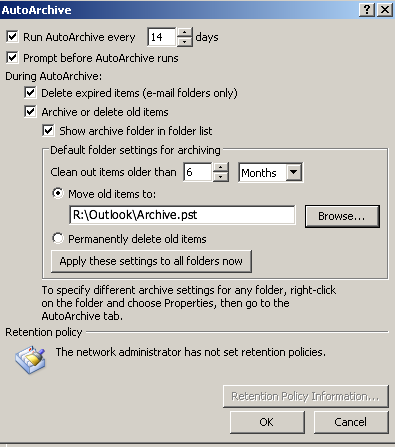The content of this document may be incorrect or outdated.
Print this article Edit this article
Archiving for ECN users of ITaP Exchange server
ECN now recommends increasing your Exchange storage space instead of archiving emails. Additional information can be found at http://eng.purdue.edu/jump/9ccded
Summary:
ECN users of ITaP's exchange server often find the need to archive some of their email into an Archive File (an Offline PST file).
There are recommended locations for the archive file, as well as various options that can be chosen to utilize the archive file.
Archiving can either be manual, involving moving mail from the online exchange store to the offline PST store, or automatic, based on Outlook's internal method of choosing messages and items older than a certain date and automatically moving it into the Archive file.
Alternative:
If you do not wish to create an offline Archive folder, your only other option is to find and delete emails with the largest attachments. On average, the top ten largest emails take up 20% of your email storage space. Going through these might solve your space issue with the minimum of effort on your part.
- To find your largest files, make sure you are in your Inbox, and go to Tools>Instant Search>Advanced Find (Keyboard shortcut- Ctrl+Shift+F)
- Go to the Browse button, make sure the top level Mailbox is chosen, as well as "Search Subfolders". Click OK.
- Navigate to the More Choices tab, choose Size "Is Greater Than" and input 2000. Then click search.
- Sort your results by size, and this will show you your largest emails. Either delete the largest emails outright or open them up, save the attachment, and then delete the email.
- Make sure you empty your deleted items as well.
Setting up the Archive file:
WARNING! Incorrectly implementing this feature can result in irretrievable loss of email!
- Under Outlook, click on File> New> Outlook Data File - choose the creation of the default Office Outlook Personal Folders file (.pst)
-
The location to store this file should ALWAYS* be:
- For ECN Domain machines: R:\Outlook (Create the Outlook Folder if it does not already exist).
- For Technology SOT Domain machines: H:\Outlook (Create the Outlook Folder if it does not already exist)
- Call the File name Archive.pst
- Under the dialog box that appears next, make sure the "Name" field also shows Archive (that is, identical to the file name you chose in the last step).
- You can ignore the password field, you do not need to use a password.
- The Archive file will now show up in the folder list.
Using the Archive File Manually:
1. in Outlook's main window, in the folder list at left, select the folder you want to archive
2. click on the File menu and select "Archive"
3. in the dialog, set the date; messages older than the date you choose will be moved into the archive
4. also set the location for the archive file; point to the archive file you just created: R:\Outlook\archive.pst
Using the Archive File with Outlook's AutoArchive feature:
1. Under Outlook's Tools menu, go to Options, and go to the tab marked "Other"
2. Click the "Autoarchive" button
3. Make the various boxes resemble the picture included below- you can change the various timing options as needed
That's it.
Note that you can manually archive your items by choosing File> Archive> and choosing "Archive everything per my autoarchive settings"
*: Some people who have access to a shared network space have successfully used that space to store a work-related archive.
If this strategy is used, the location as well as file and display names just need to be clear and descriptive (instead of "Outlook.pst" or "Archive.pst")
If you have questions, please ask your site specialist by sending an email via the Trouble Report BEFORE setting up archiving.
Last Modified:
Sep 14, 2019 6:33 am America/New_York
Created:
Feb 11, 2009 9:27 am US/Eastern
by
admin
JumpURL: https://eng.purdue.edu/jump/2ae7f9

